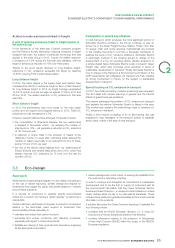APC 2012 Annual Report Download - page 67
Download and view the complete annual report
Please find page 67 of the 2012 APC annual report below. You can navigate through the pages in the report by either clicking on the pages listed below, or by using the keyword search tool below to find specific information within the annual report.
2012 REGISTRATION DOCUMENT SCHNEIDER ELECTRIC 65
SUSTAINABLE DEVELOPMENT
2
SCHNEIDER ELECTRIC’S COMMITMENT TO ENVIRONMENTAL PERFORMANCE
Actions to reduce emissions linked to freight
A goal of reducing emissions linked to freight applies to
the entire Group
In the framework of the three-year Connect company program
and the Planet&Society Barometer, reducing emissions in freight
transport has been the subject of particular monitoring and was
applied to the entire Group in2012. A goal of a relative reduction
in emissions of 3.5% during the fi rst year was validated, with the
target of achieving a reduction of 10% over three years.
Thanks to the good results obtained on long distance freight,
reductions in CO2 emissions exceeded the target by reaching
14.80%, covering 81 % of paid transportation.
Long distance freight
In2012, the major players in the supply chain and logistics have
increased their efforts to reduce air freight in favor of sea transport
for long distance freight. In2012, air freight tonnage represented
13.3% of joint air and sea tonnage, as against 17.9% in2011 and
20% in2010. The relative reduction in CO2 emissions in this area
was 28%.
Short distance freight
In 2012, the performance was more mixed on the road carrier
portion and will require more targeted actions in2013. Total CO2
emissions on road increased by 4.7%.
However, several initiatives have emerged. Of special note are:
•the consolidation of shipments between the two warehouses
in England in November which – by reducing the number of
shipments by 13%– will generate a reduction in CO2 emissions
of 157tons per year;
•a reduction in empty miles in the provision of trailers at the
distribution center in Leeds after optimizing loads allowed the
number of trailers used daily to be reduced from four to three,
saving 14tons of CO2 per year;
•the use of the Alpine rolling highway from our warehouses at
Evreux (France) and Venaria (Italy) since June2012, which has
already reduced CO2 emissions by 13 tons over the last six
months of2012.
Participation in several key initiatives
In road transport, which produces the most signifi cant portion of
Schneider Electric’s emissions, the Group continues to play an
active role in the Green Freight Europe initiative. Today, more than
70 supply chain and some shipping multinationals are involved
in this initiative that aims to promote a European framework to
address the issue of CO2 transport emissions. Schneider Electric
is particularly involved in the working groups in charge of the
development of a tool for reporting carbon dioxide emissions on
a simple shared basis. Schneider Electric is also involved in Green
Freight Asia, which also promotes good practices in terms of
sustainable development in transport. Finally, Schneider Electric is
now in charge of the Transport&Environment Commission of the
AUTF (Association des Utilisateurs de Transport de Fret), marking
its strong involvement in France on the subject of sustainable
development in transport.
Special training on CO
2
emissions in transport
In2012, two distance-training modules (e-learning) were prepared.
The fi rst deals with climate warming in general and the harmful
effects of greenhouse gas emissions.
The second addresses the problem of CO2 emissions in transport
and explains the actions Schneider Electric is taking in this area.
This module also explains the methodology used to measure our
CO2 emissions in transport.
Finally, a third module consisting of an on-site training day was
designed to help managers of the transport activity to establish
action plans, mainly in the area of road transport.
3.3 Eco-Design
Approach
While there is no general legal obligation on eco-design, the pressure
on the use of natural resources, climate change and respect for
biodiversity encourages the public and private players to mobilize
around these questions.
It is unusual for customers to explicitly specify environmental
criteria for a product, but having a “green supplier” is becoming a
prerequisite.
Global customers, particularly in the green construction or transport
sectors or the authorities, need support to implement their
environmental policies, especially to:
•calculate and reduce their carbon footprint;
•anticipate and ensure conformity with statutory provisions,
especially with regard to chemical products;
•facilitate eco-design of their products and services by supplying
all the appropriate information;
•reduce management costs of end-of-working-life installations for
the customer by optimizing recycling.
In order to continue and strengthen its commitment to sustainable
development and to be the fi rst to supply its customers with all
the environmental information that they need, Schneider Electric
developed Green Premium –a unique eco-brand based on criteria
clearly defi ned either by law or by international standards. These
criteria include easily and globally accessible ad hoc environmental
information on its products.
A solution falls under the Green Premium branding if it satisfi es the
four following criteria:
•complies with the RoHS European directive, i.e., it does not
include one of the six substances stated in this directive;
•contains information relating to the presence of Substances
of Very High Concern (SVHC) within the scope of the REACH
European regulation;
























